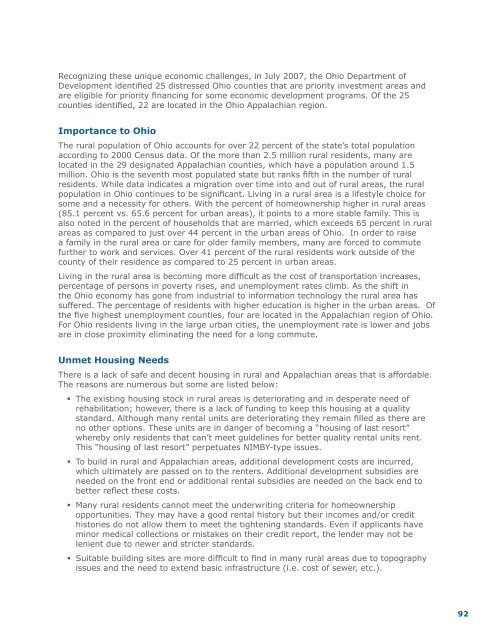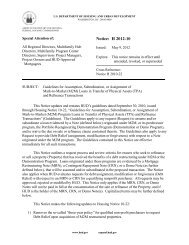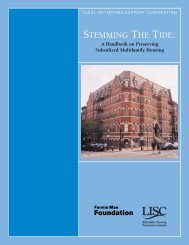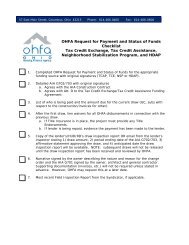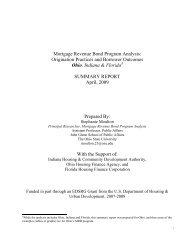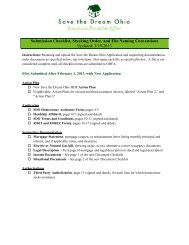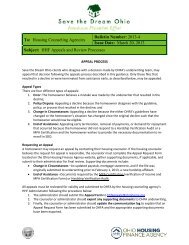OHFA Annual Plan - Ohio Housing Finance Agency
OHFA Annual Plan - Ohio Housing Finance Agency
OHFA Annual Plan - Ohio Housing Finance Agency
You also want an ePaper? Increase the reach of your titles
YUMPU automatically turns print PDFs into web optimized ePapers that Google loves.
Recognizing these unique economic challenges, in July 2007, the <strong>Ohio</strong> Department ofDevelopment identified 25 distressed <strong>Ohio</strong> counties that are priority investment areas andare eligible for priority financing for some economic development programs. Of the 25counties identified, 22 are located in the <strong>Ohio</strong> Appalachian region.Importance to <strong>Ohio</strong>The rural population of <strong>Ohio</strong> accounts for over 22 percent of the state’s total populationaccording to 2000 Census data. Of the more than 2.5 million rural residents, many arelocated in the 29 designated Appalachian counties, which have a population around 1.5million. <strong>Ohio</strong> is the seventh most populated state but ranks fifth in the number of ruralresidents. While data indicates a migration over time into and out of rural areas, the ruralpopulation in <strong>Ohio</strong> continues to be significant. Living in a rural area is a lifestyle choice forsome and a necessity for others. With the percent of homeownership higher in rural areas(85.1 percent vs. 65.6 percent for urban areas), it points to a more stable family. This isalso noted in the percent of households that are married, which exceeds 65 percent in ruralareas as compared to just over 44 percent in the urban areas of <strong>Ohio</strong>. In order to raisea family in the rural area or care for older family members, many are forced to commutefurther to work and services. Over 41 percent of the rural residents work outside of thecounty of their residence as compared to 25 percent in urban areas.Living in the rural area is becoming more difficult as the cost of transportation increases,percentage of persons in poverty rises, and unemployment rates climb. As the shift inthe <strong>Ohio</strong> economy has gone from industrial to information technology the rural area hassuffered. The percentage of residents with higher education is higher in the urban areas. Ofthe five highest unemployment counties, four are located in the Appalachian region of <strong>Ohio</strong>.For <strong>Ohio</strong> residents living in the large urban cities, the unemployment rate is lower and jobsare in close proximity eliminating the need for a long commute.Unmet <strong>Housing</strong> NeedsThere is a lack of safe and decent housing in rural and Appalachian areas that is affordable.The reasons are numerous but some are listed below:• The existing housing stock in rural areas is deteriorating and in desperate need ofrehabilitation; however, there is a lack of funding to keep this housing at a qualitystandard. Although many rental units are deteriorating they remain filled as there areno other options. These units are in danger of becoming a “housing of last resort”whereby only residents that can’t meet guidelines for better quality rental units rent.This “housing of last resort” perpetuates NIMBY-type issues.• To build in rural and Appalachian areas, additional development costs are incurred,which ultimately are passed on to the renters. Additional development subsidies areneeded on the front end or additional rental subsidies are needed on the back end tobetter reflect these costs.• Many rural residents cannot meet the underwriting criteria for homeownershipopportunities. They may have a good rental history but their incomes and/or credithistories do not allow them to meet the tightening standards. Even if applicants haveminor medical collections or mistakes on their credit report, the lender may not belenient due to newer and stricter standards.• Suitable building sites are more difficult to find in many rural areas due to topographyissues and the need to extend basic infrastructure (i.e. cost of sewer, etc.).92


